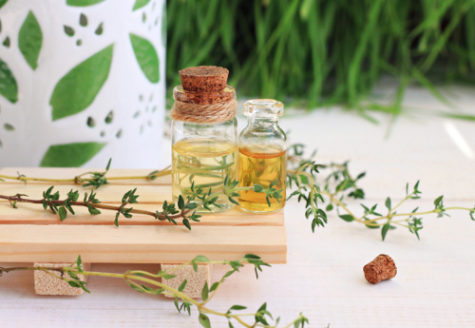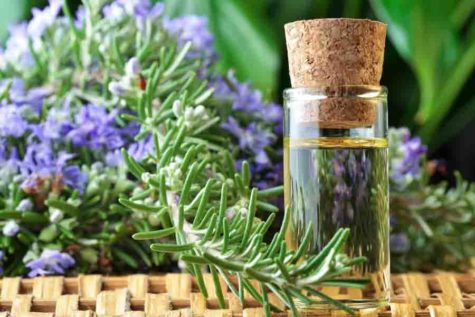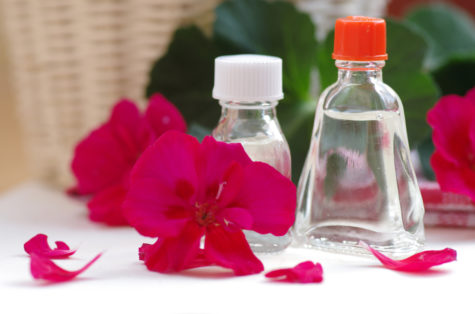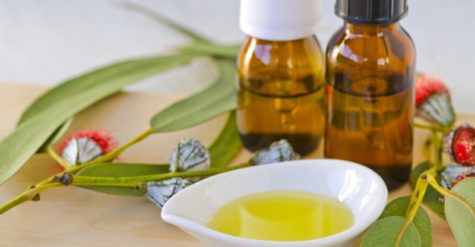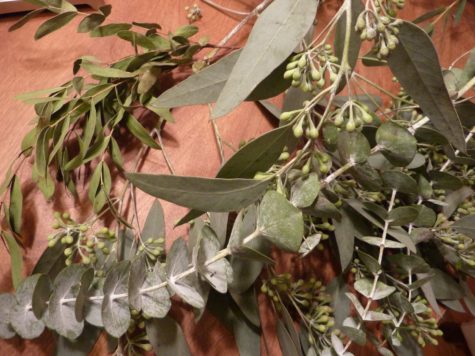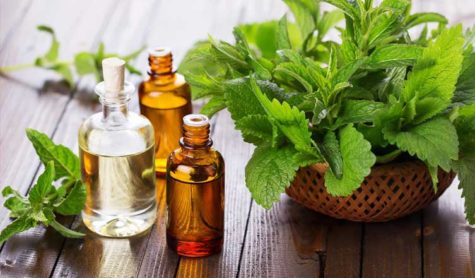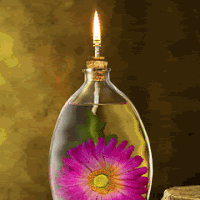Monthly Archives: May 2018
Essential Oils for Abdominal Pain
Abdominal pain should be checked by a doctor if it persists and increases in intensity because it could be appendicitis or another condition that needs to be properly diagnosed.
Upper Abdominal Area:
Apply the following oil over the painful area in a clockwise direction:
- 3 drops Peppermint
- 2 drops Clove
Dilute in 1 teaspoon vegetable or carrier oil.
Other essential oils that could be used include the following: Angelica, Anise, Chamomile, Coriander, Eucalyptus, Fennel, Marjoram
Lower Abdominal Area:
Apply the following oil over the painful area in a clockwise direction:
- 2 drops Thyme
- 3 drops Eucalyptus
Dilute in 1 teaspoon vegetable or carrier oil.
Other essential oils that could be used include the following: Geranium, Ginger, Patchouli, Peppermint, Rosemary
Source: Complete Book of Essential oils and Aromatherapy
Thyme Essential Oil
There are many types of thyme, some of which can be used safely in all situations and some which cannot. Thyme oil ranks high on the versatility index of essential oils. Diffused, it boosts wellness, fortifying the lungs and clearing the breath.
Thyme has notable antiviral, antibiotic, antiseptic, and diuretic properties and should be used with great care.
- Application:
Thyme oil should never be used undiluted on the skin. It can be applied topically at very low dilutions of 1% or less or used in a blend as a compress. It may also be used in direct inhalation or diffused. Add to food or soy / rice milk as a dietary supplement or flavoring.
- Fragrant Influence:
It may be beneficial in helping to overcome fatigue and exhaustion after illness.
- Safety Data:
Overuse of Thyme essential oil can stimulate the thyroid gland and lymphatic system. Like many good things, it must be used in moderation. It should never be applied to the skin undiluted and should not be used on children unless it is within the chemotype Thyme linalol. It can be irritating for the mucus membranes and it should not be used by those who are pregnant.
Thyme is a vital component of the Basic Care Kit because of its powerful antiviral properties. When flu is around it is a wonderful oil to have on the diffuser. It assists in the elimination of toxic wastes from the body. It is used in the treatment of a wide range of conditions including whooping cough, warts, rheumatism, neuralgia, fatigue, and acne.
Inhaled, Thyme oil is uplifting and relieves depression, stimulates the respiratory system and relieves the spasm of asthma, is an antiseptic for all sorts of muccoid conditions, kills bacteria in the air, and is used for bronchitis or pneumonia. Thyme oil is also mildly sedating and can be used for insomnia.
Internal dose is three to five drops in honey water three times a day.
It is also extremely useful in antiseptic powders, hair and skin care regimes, and cooking. Just to make it a perfect all-rounder, thyme will discourage all manner of parasites and insects from invading your home.
In Greek, “thymos” means “to perfume”; one of thyme’s many traditional uses was in fumigation. Ancient Egyptians used thyme oil for embalming. In many ancient cultures, it was believed that thyme instilled the virtues of strength, energy, and bravery.
Variations
There are six different chemotypes of T. vulgaris:
- Thymol – low altitude close to the sea
- Carvacrol – low altitude close to the sea
- Linalool – in the sun on exposed slopes
- Geraniol – rare and mixed with linalool at high altitudes
- Thuyan-4-ol – very rare and located between thymol/carvacrol and linalool
- α-terpinyl – in the Eastern Mediterranean
Thyme Linalol is especially recommended to kill bacteria and relieve discomfort. It is non-irritating and gentle, and especially recommended for treating children and the elderly or infirm.
Thyme Thuyanol is quite new. It captures much of the overall strength and stimulating properties of the “regular” essence of Thyme as well as its anti-infectious properties. The difference lies in the much higher content of highly desirable terpene alcohols (non-toxic) and the much lower content of irritant and slightly toxic phenols. This oil is stronglhy germicidal (yet non-irritant) and a very good liver stimulant.
Information collected from various sources
Hair and Scalp Formula
- 8 drops Rosemary oil
- 4 drops Cedar oil
- 4 drops Lemongrass oil
- 4 drops Peppermint oil
- 4 drops Lavender oil
Add the essential oils to 30 ml of jojoba oil and massage into hair and scalp. 10% argan oil will enhance this formula.
Source: Floracopeia
Deep Breath Oil Blend
Mental Clarity Inhalation Blend
- 8 drops Rosemary oil
- 4 drops Peppermint oil
- 4 drops Lemon oil.
Use neat if diffusing, or dilute with 15 ml of carrier oil for direct inhalation.
Source: Floracopeia
Rosemary Essential Oil
Rosemary is both a physical and mental stimulant, which makes it a good oil to have in the morning bath, while also being excellent in the treatment of all muscular conditions, making it the perfect oil for a bath after a long tiring day.
- Application:
Diffuse, inhale, or apply topically on location. Add to food or soy / rice milk as a dietary supplement or flavoring.
- Fragrant Influence:
Helps overcome mental fatigue and improves mental clarity and focus.
- Safety Data:
Rosemary essential oil should not be used by those who suffer from hypertension, those who are pregnant and those who have epilepsy.
Tisserand and Young warn that Rosemary Oil is potentially neurotoxic, depending on the level of camphor present in the oil. They also warn not to use on or near the face of infants and children. They recommend dermal maximum s of 16.5% for Rosemary Camphor and 6.5% for Rosemary Verbenone.
Rosemary has become very popular as a medicinal plant, because it can be used for so many different conditions and symptoms. The oil is known to have rejuvenating properties so is often used in skin and hair care and the claimed memory boost means that it is a popular oil with students.
This antiseptic oil is used in the treatment of muscular spasms, arthritis, rheumatism, depression, fatigue, memory loss, migraine, headaches, coughs, flu, and diabetes, among other conditions.
It is also very useful in beauty treatments, being used in hair care and acne and cellulite remedies. For the sportsman, cook, and gardener, rosemary is invaluable.
Rosemary was part of the “Marselles Vinegar” or “Four Thieves Vinegar” used by grave-robbing bandits to protect themselves during the 15th century plague.
The name of the oil is derived from the Latin words for dew of the sea (ros + marinus). According to folklore history, rosemary originally had white flowers; however, they turned red after the Virgin Mary laid her cloak on the bush.
Since the time of ancient Greece (about 1000 BC), rosemary was burnt as incense. Later cultures believed that it warded off devils, a practice that eventually became adopted by the sick who then burned rosemary to protect against infection. Until recently, French hospitals used rosemary to disinfect the air.
Variations
Several chemotypes of R. officinalis have been defined, depending on where the plant is grown and what the local conditions are. The main three are as follows:
- Camphor-Borneol
- Cineole
- Verbenone
The camphor-borneol variety is considered the best stimulant whereas the verbenone is considered the most gentle and often used in topical preparations. One of the “Oils of Protection”, pleasant, warming and mildly sweet rosemary verbenone is a softer version of the more common and pungent cineole variety. Rosemary Cineole is sometimes preferred for use in respiratory and circulatory issues.
Information collected from various sources
Geranium Essential Oil
Geranium works profoundly on the emotions and is useful in many medical conditions – and smells wonderful while it works so hard. The oil is extracted not from the familiar brightly colored geranium but from the species Pelargonium – Geranium Robert or “lemon plant” – which is very often displayed in abundance in Greek restaurants.
- Application:
Diffuse and apply topically. May be added to food or soy / rice milk as a dietary supplement. Apply where you would use a deodorant.
- Fragrant Influence:
It may help to release negative memories. It may also help ease nervous tension and stress, balance the emotions, lift the spirit, and foster peace, well-being, and hope.
- Safety Data:
If pregnant or under a doctor’s care, consult your physician.
Geranium will make chilblains disappear overnight and brings a radiant glow when used in skin care. This oil is useful in applications for aged, wrinkling or older skin, as well as for healing balms and salves after facial or plastic surgery.
More importantly, it is a vital component in the treatment of endometriosis, is very effective for menopausal problems, diabetes, blood disorders, throat infections, and as a nerve tonic, and works well as a sedative.
When inhaled the scent is antidepressant, uplifting, averts tension, and is stimulating to the psyche.
It is reputed to help in cases of uterine and breast cancer and if nothing else, would certainly help the patient to relax and cope with the pain. Geranium has many applications, from frostbite to infertility, and its antiseptic and astringent properties contribute to its general usefulness. Its delightful floral fragrance makes it a pleasure to use, either on its own or as a contributory oil in blends.
Information collected from various sources
Eucalyptus Essential Oil
Eucalyptus has been distilled from at least 1788 when two doctors, John White and Dennis Cossiden, distilled Eucalyptus piperata for its use in treating chest problems and colic. This was in Australia where the Blue Mountains of New South Wales are so called because of the extraordinary blue haze that exudes from the resin of the eucalyptus gum and envelops the entire landscape. In such a powerfully aromatic environment, the medicinal qualities of this ancient tree would be hard to miss.
There is a wide range of eucalyptus varieties, any one of which would be a useful addition to a Basic Care Kit. Eucalyptus oil is steam-distilled from a number of different variations of the tree Eucalyptus spp. Each of these oils are from one specified chemical race, rather like Zinfadel wine is of one variety but each vineyard produces a Zinfadel of a particular quality and taste.
Generalities:
Eucalyptus is a marvelously versatile and useful oil. It cools the body in summer and protects it in winter. It is antinflammatory, antiseptic, antibiotic, diuretic, analgesic, and deodorizing. Research has proved its antiviral properties as well.
It is best known for its effectiveness against coughs and colds but is equally effective in the treatment of cystitis, candida, diabetes, and sunburn, while also being useful in veterinary care and as an insect repellent.
In general, Eucalyptus oil is used as a specific for the respiratory system. It is an antiseptic stimulant with a very specific balsamic odor that can only be described as smelling like Eucalyptus. This oil has great value in a vaporizer to stimulate and loosen bronchial secretions so that they can be coughed up, and is used primarily for coughs, colds, bronchial infections and asthma. Eucalyptus oil is very effective in killing bacteria and for clearing the system when used in a vaporizer. It is antiviral and cooling.
Eucalyptus citriodora
Also known as Lemon Eucalyptus or Lemon-Scented Gum. Eucalyptus citriodora has been used to perfume linen closets, and as an insect repellent, especially for cockroaches and silverfish.
- Application:
Diffuse or rub on bottom of feet or on location
- Fragrant Influence:
Has a sweet, strong, camphorous, fresh lemony scent. Citronella like. It promotes health, well being, purification, and healing.
- Safety Data:
If pregnant or under a doctor’s care, consult your physician, Do not take internally.
Also used for asthma, athlete’s foot and other fungal infections, respiratory infections, cuts, dandruff, fevers, herpes, infectious skin conditions, laryngitis, scabs, shingles, sore throat, sores and wounds.
Eucalyptus dives
This species has a different, more specific antibacterial action than other eucalyptus oils.
- Application:
Apply topically or diffuse. Avoid direct inhalation.
- Fragrant Influence:
It promotes health, well being, purification, and healing.
- Safety Data:
If pregnant or under a doctor’s care, consult your physician.
Containing low amounts of eucalyptol, Eucalyptus dives is mild and gentle. This variety is ideal for topical application.
Eucalyptus globulus
Also known as Blue-Gum or Tasmanian Blue Gum Eucalyptus. This essential oil usually has the highest 1,8-cineole levels and is heavily cultivated in Portugal, Spain and China.
For centuries Australian Aborigines used the leaves as a disinfectant to cover wounds. Shown by laboratory tests to be a powerful antimicrobial agent, E globulus contains a high percentage of eucalyptol (a key ingredient in many antiseptic mouth rinses). Often used for the respiratory system, eucalyptus has been investigated for its powerful insect repellent effects.
- Application:
Apply topically, diffuse, or use in a humidifier.
- Fragrant Influence:
It promotes health, well being, purification, and healing. A fresh, strong, uplifting scent that is medicinal, herbal and clean. A typical Eucalyptus odor.
- Safety Data:
If pregnant or under a doctor’s care, consult your physician. Do not take internally.
Eucalyptus trees have been planted throughout parts of North Africa to successfully block the spread of malaria. According to Jean Valnet, MD, a solution of 2% eucalyptus oil sprayed in the air will kill 70% of airborne staph bacteria. Some doctors still use solutions of eucalyptus oil in surgical dressings.
This oil may be used for aches and pains, acne, allergies, arthritis, bronchitis, burns, decongestant, respiratory infections, cystitis, endometriosis, increasing energy, gonorrhea, inflammation of the ear, eye, and sinus, malaria, rheumatism, respiratory infections, skin and throat infection or sores, ulcers, vaginitis, and wounds.
Eucalyptus polybractea
Used for acne and cystitis.
- Application:
Diffuse or apply topically, or use in a humidifier
- Fragrant Influence:
It promotes health, well being, purification, and healing.
- Safety Data:
If pregnant or under a doctor’s care, consult your physician. Do not take internally.
Containing 95% Eucalyptol, Eucalyptus polybractea is one of the most potent of the Eucalyptus oils. Eucalyptol is a well known constituent in dental products and insect repellents. Anti-infectious, antiviral, antibacterial, and anti-inflammatory, expectorant, and insect repellent. Has traditionally been used topically to support healthy respiratory function.
Eucalyptus radiata
Also known as Narrow-Leaved Peppermint. This is thought to be the most therapeutic Eucalyptus essential oil. An antimicrobial oil studied for its action against viruses. This oil is used extensively for respiratory infections.
- Application:
Diffuse or rub on bottom of feet or on location, or use in a humidifier.
- Fragrant Influence:
The scent is similar to globulus in that it is medicinal and clean, but also with peppery and camphorous aromas. It promotes health, well being, purification, and healing.
- Safety Data:
If pregnant or under a doctor’s care, consult your physician. Do not take internally.
This oil contains citrol, a constituent known for its cleansing abilities. When combined with bergamot, Eucalyptus radiata has been used effectively on herpes simplex. It may also help with acne, bronchitis, ear inflammation, endometriosis, nasal and sinus congestion, sinusitis, and vaginitis.
Information collected from various sources.
Chamomile Essential Oil
There are several types of chamomile essential oil. German Chamomile is an excellent variety and its beautiful deep dark blue color, due to its high azulene content, comes as a bonus. Another excellent variety, Roman chamomile, is particularly good for the treatment of nervous conditions and insomnia. Beware though of chamomile Maroc (Ormenis multicaulis) which is not a true chamomile and cannot be used as such.
Generalities
Chamomile is that wonderful yellow daily-like flower that is used for everything: cosmetics, fragrance, oil, herbal baths, soothing tea. The root is used for toothache and the entire plant in herbal therapeutics. The whole plant is used from root to flower. The essence is obtained by steam distillation of the flowers. Chamomile smells sweet, resembling fresh golden apples, and this fruity scent has given it the name of Manzanilla in Spanish-speaking countries.
The Egyptians had a great reverence for Chamomile and used it in massage oils to remove aches and pains. Sports-minded people will like using the flowers in a bath for relaxation and to ease aching muscles. This plant was one of the favored strewing herbs of the Middle Ages, to sweeten the air of a room and create a relaxing atmosphere.
The scent is rejuvenative and especially helpful to those of a sensitive nature. Inhaling the herby, aromatic, slightly bitter but always refreshing scent of Chamomile will ease your depression, soothe your irritable nature, lull you into a restful sleep and calm you. Use the oil straight or use it in combinations to relax and soothe a busy household after a trying day.
A busy person might like dabbing a drop or two of Chamomile oil on the forearm, to inhale occasionally during the day , for relaxation and to allay temper. Remember that oil of Chamomile is recommended for use in the diffusor, in a child’s room, for the anesthetic, for the calm that will come, for sweet sleep.
German Chamomile
German chamomile has been highly esteemed for over 3,000 years and has been used for many types of skin conditions and stress related complaints.
- Application:
Diffuse, add to food or water as a dietary supplement, or apply topically on location. Among the gentlest oils used in aromatherapy, the chamomiles are suitable for use on children.
- Fragrant Influence:
Dispels anger, stabilizes emotions, and helps release emotions linked to the past. It may also be used to soothe and clear the mind.
- Safety Data:
If pregnant or under a doctor’s care, consult your physician.
German chamomile is a cleanser of the blood, helps increase liver function and secretion, and supports the pancreas. German chamomile promotes the regeneration of skin and can be used for abscesses, burns, rashes, cuts, dermatitis, teething pains, acne, eczema, chronic gastritis, infected nails, cystitis, inflamed joints, menopausal problems, sores, skin disorders, stress related complaints, toothaches, ulcers and wounds.
Roman Chamomile
Roman chamomile is used extensively in Europe for the skin. For centuries, mothers have used Roman chamomile to calm crying children, ease earaches, reduce fevers, soothe stomachaches and indigestion, and relieve toothaches and teething pain.
- Application:
Diffuse or apply topically on bottom of feet, ankles, wrists or on location. Add to food or soy / rice milk as a dietary supplement. Among the gentlest oils used in aromatherapy. All of the chamomiles are suitable for use on children.
- Fragrant Influence:
Because it is calming and relaxing, it can combat depression, insomnia, and stress. It minimizes anxiety, irritability, and nervousness. It may also dispel anger, stabilize the emotions, and help to release emotions that are linked to the past.
- Safety Data:
If pregnant or under a doctor’s care, consult your physician. Test for skin sensitivity.
Roman chamomile neutralizes allergies and increases the ability of the skin to regenerate. It may help calm and relieve restlessness and tension. Its anti-infectious properties benefit cuts, scrapes, and bruises It is a cleanser of the blood and also helps the liver discharge poisons.
This oil may help with allergies, bruises, cuts, depression, insomnia, muscle tension, nerves (calming and promoting nerve health), restless legs, and skin conditions, such as acne, dermatitis, eczema, rashes, and sensitive skin. It can effectively minimize irritability and nervousness in hyperactive children.
Collected from various sources
Peppermint Essential Oil
Peppermint has been used by many ancient cultures, including the Egyptians, Chinese, and American Indians, no doubt because of its extremely useful health-promoting properties.
- Application:
Diffuse. Massage on the stomach or add to water or tea for supporting normal digestion. Apply to bottom of feet or rub on the temples to treat headaches. To improve concentration, alertness, and memory, place 2 drops on the tongue. Add to food as a flavoring and preservative. Add a drop or two to a bottle of water curb appetite, and for a cooling refreshment on a hot day.
- Fragrant Influence:
It is purifying and stimulating to the conscious mind.
- Safety Data:
If pregnant or under a doctor’s care, consult your physician. Avoid contact with eyes, mucus membranes, or sensitive skin areas. Do not apply “neat” to a fresh wound or burn.
Peppermint is one of the oldest and most highly regarded herbs for soothing digestion, and has been extensively studied for it’s effect on the liver and respiratory systems. Peppermint has also been researched for it’s role in affecting impaired taste and smell when inhaled, and it’s ability to improve concentration and mental accuracy.
One study examined peppermint’s ability to directly affect the brain’s satiety center which triggers a sensation of fullness after meals.
It is an excellent digestive, it helps the respiratory system and circulation, it is an anti-inflammatory, and an antiseptic. These qualities make it a good oil in the treatment of indigestion, flatulence, bad breath, flu, catarrh, varicose veins, headaches and migraines, skin irritations, rheumatism, toothache, and fatigue. It even keeps mice, fleas, and ants away.
If you chew on a Peppermint leaf and then suck in air, a distinct cooling effect will be felt in your mouth. This cooling effect is from the presence of menthol, which is useful in making cosmetics and body-care products.
Peppermint oil is extremely useful when you are hot either from a hot fever, hot flashes, or hot weather. Inhaled it cools a fever, decongests the sinuses, calms the mind, soothes a headache, acts as an antidepressant, stimulates the nervous system and mind, also calms the tendency for your mind to race.
- External Uses
Peppermint oil is used as an antiseptic to wounds and sores (use only in a very diluted form), as a chest rub for respiratory diseases (use in a blend of oils or fats), as a skin cleanser (hydrosol or water spray), and in rubs for aching muscles and limbs.
- Internal Uses
Peppermint oil has a proven reputation to cure nausea and vomiting. One drop on a sugar cube sucked slowly, or two drops in 8 ounces of water and slowly sipped.
Always use Peppermint oil diluted, as it can burn and irritate when used neat. Peppermint oil in a lotion has an interesting feature in that it cools while it warms. The menthol increases blood flow wherever it is applied, soothes while it gives a cooling feeling. Try it as a muscle rub for tired feet.
Peppermint oil can also be added to water and given to both pets and people to cure flatulence. One or two drops of peppermint oil per 6 oz of water should be sufficiently strong enough to cure the problem.
Collected from various sources

